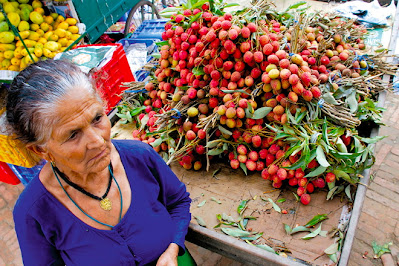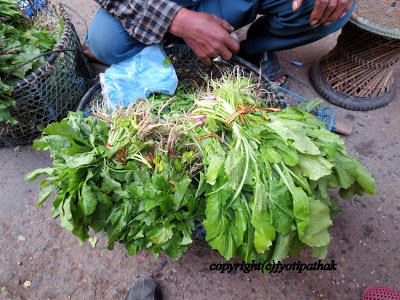I’m fascinated with the way they build homes and other buildings in Nepal. I love to pause as I see a house being built and just watch for a bit. There is seldom an electric tool at all and there is never any safety equipment for the workers. I wrote another blog post about workers and workers’ issues about a year ago. But now my fascination with buildings has taken on a more personal prospective.
Notice how the buildings on either side of this home being constructed have to be propped up.
I’ve been living in a lovely apartment for over a year, actually through two winter seasons. Although I’ve enjoyed this place there have been holes in my little paradise, mostly due to the way the home was built. First of all, there is so little wood in the buildings you will only find wood in the window frames and doors. The rest of the building is brick and concrete, period. Additionally, there is no aluminum, so the windows are never sealed well and double pane glass does not exist here.
So, when my neighbor downstairs opens the door to let the dog outside I know it because I feel a blast of cold air filling the room. When I go downstairs to discuss it with them I see them wearing hats, jackets and shawls like they are dressed to go out. Of course, now that it’s March it’s getting much warmer, but I still need to put a shawl over my shoulders throughout the day, taking it off and then looking for it again a few moments later. Sometimes I just go up to the roof to warm up so I’m not so bothered by the temperature changes.
What is the solution? My options seem to be a bit limited. I can stay here and deal with it. My landlord said he would put some weather strip around my door and make sure the front door stays closed, but I have to wonder why they are just now thinking of it. I even bought and installed braces for the doors that cause them to close somewhat automatically. It helps only marginally.
Another issue in the Kathmandu Valley and in many villages throughout Nepal is that homes are built so close to each other that there is no possibility for windows or sunshine. One can see many buildings with windows only on the front and back, which makes them very difficult to light naturally. And with only a few hours a day of electric each spring it makes living like that very difficult. The government cuts load shed during finals week so students can study, but that doesn’t help during the long hours of darkness in the winter and spring.
Notice these building have little possibility of side windows at all.
Load shed is just something people here learn to live with. When the lights go out we know to go through the house and turn off all the light switches to save electric when the lights come back on. Typically, they use their rechargeable lamps or candles at this time so there is a little bit of light. These rechargeable lamps are seldom light enough to read by. And even when the building has back up electric the bulbs are very low wattage, and not quite bright enough.
Tip: If you come to Nepal and need 24 hours of electricity be sure to ask if there is a hot plug in for charging your computer in addition to the light fixtures. Otherwise you will be very disappointed to be sitting in the ‘almost dark’ and not be able to use your computer, so if that is an issue you will likely need to pay a bit more. Another question to ask is if they have the WIFI connected to the inverter.
Tip: If you come to Nepal in the spring time you will do well to select a guest house with an outdoor garden area. Such guest houses make mingling with other tourists much easier and can provide an enjoyable place to hang out when there is no electricity.
This is the rooftop of the Norling Guest House in Jayta area near Thamel.
This guest house, for example, has starting prices under (or around) $20. It is well maintained and a bargain compared to many guest houses in Thamel. An additional advantage is that it is within walking distance to the tourist buses leaving the Valley for places like Pokhara, Chitwan or Lumbini. This will save you 500 NRs. for taxi fare due to the buses leaving so early in the morning. Norling Guest House You can find tips on how to get the best price at guest houses in my eBook, Nepal: A Tourist's Manual.
One can easily see from this photo how everything is done almost entirely without electrical tools. On the far right you can see how the pillars are formed by wood molds. These pillars are filled with concrete by hand, one dish full at a time. Additionally, there is no safety equipment of any kind.
One interesting thing about Nepali culture is the way they build homes in stages. When I had first gotten to Nepal I saw what I thought was damage from their recent civil war. No, it is the way they build homes. Re-bar is sometimes just sticking up, ready for the next floor to be built. This home is two stories with nothing but bamboo railing and the children entertain themselves by playing leap-frog on the roof. Because most of the land is used for farming there is little place for children to play in the cities.

 |
| As I sat having lunch with a friend, I watched this worker 6 floors up! |
Did you know I wrote an eBook filled with tips on getting the most out of your visit to Nepal?
Satisfaction Guaranteed: NO FINE PRINT. If you don't truly love Nepal: A Tourist’s Manual, please send for 100% money back. If you are not completely satisfied just send your purchase information along with a note to: FrugalTravelsNepal@gmail.com
Nepal: A Tourist’s Manual-For more information check out our website. If you enjoy this blog and the website you will enjoy the 299 page eBook. It is a well illustrated, easy read with over 1,000 tips to help you get the most out of Nepal.
Visit my website:
Nepal: A Tourist's Manual



.jpg)









Comments
Post a Comment